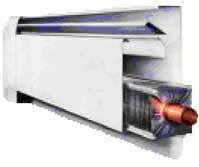Baseboard Radiators
In the baseboard hydronic heating systems (shown below), water is heated in a gas-fired or oil-fired furnace located in the basement. The heated water is distributed through pipes into baseboards in various rooms. The heat is then delivered through radiation and convection. Although these are called radiant heating systems, most of the heat delivered is by convection. Heat delivery into rooms or zones can be controlled by flaps or louvers.
Baseboard Radiators
A picture of a baseboard heater is shown below. Closely spaced metallic sheets called “fins” increase the surface area for efficient heat transfer into the room.

Baseboard Heater
Advantages and Disadvantages of Radiant Baseboard Heating
| Advantages | Disadvantages |
|---|---|
| In general, it operates quietly. | Cannot be used for cooling. |
| It delivers constant heat and doesn't stir up allergens or dust. | High installation costs. |
| Because it warms people and objects rather than just air, it feels warm even if a door is opened or a room is somewhat drafty or slightly cooler than normal. | Interference with furniture placement. |
| There is less heat loss (waste) compared to a forced air system because there is no leakage. | Air entrapment can reduce efficiency. |